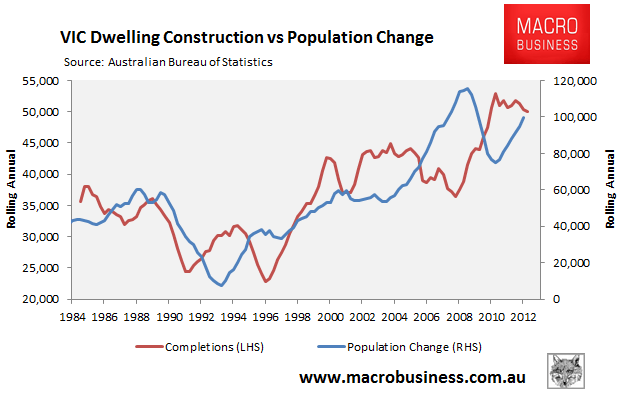
Catherine Cashmore’s excellent article published earlier in the week in Property Observer contained some inconvenient truths about Melbourne’s planning system, which Cashmore likens to Ireland’s prior to its housing crash:
Over the next 40 years, Melbourne’s population is set to expand to a projected eight million eventually putting the state in front of Sydney as the most populated…
It’s going to be nigh on impossible to please everybody. Years of poor policy have already ensured we have sparse facilities to meet the demands of those who choose to live in fringe suburbs…
The state government are taking a two pronged approach. Firstly, by deciding to enforce a permanent urban boundary to prevent further sprawl, whilst encouraging expansion of regional towns such as Bacchus Marsh, Warragul, Kilmore and Wonthaggi. And secondly, increasing the proportion of high-density accommodation by way of recent changes to residential zones.
So far, the main consensus of opinion on talk radio, television, and social media, has been virulently against all of the above – urban sprawl, increased density, and regional development, with neighbourhood voices speaking strongly against any change to their local landscape.
However, whilst heated emotions are understandable, ease of effective supply is an essential component when combating issues of affordability, and therefore, if this is what the state government intends – as spruiked in the various press releases, it must achieve the following:
1. Drive down land values
2. Ensure infrastructure is adequately financed
3. Keep speculative activity in check to make sure supply is suitably priced and attractive to lower income homebuyers and renters.
In light of the above, a few cautionary points should be highlighted in regard to Melbourne’s new plan.
When you place a band of restriction around any neighbourhood – with a ‘permanent urban growth boundary,’ you effectively make assumptions about future increases in population, and in doing so restrict the amount of developable land, resulting in a decrease not increase of supply over the longer term.In addition, larger developers have a tendency to land bank the available plots reducing competition against smaller players who don’t have the financial capital to compete so far in advance of demand.
This inevitably leads to higher, not lower land prices for the predominant demographic this type of accommodation attracts – lower wage dual income buyers.
Families require houses (not apartments) gardens, green areas and local schools. They need community facilities, a local doctor on hand, good public transport and nearby shopping centres – and they need it all at an affordable price.
Therefore, as much as idealists may not like sprawl, it’s not only important to make land readily available and free of restriction when population growth demands as such, it’s also important to implement a structured and timely plan to fund essential community infrastructure to attract consistent solid demand.
The specified areas closer to town set aside for intensive development of high-density apartment blocks will be immune from council or residential protest…
At the root of the problem lay a few issues. The relatively small one and two bedroom units featured as ‘affordable’ tend to fall into the investment sector of the market, not just because of tight lending restrictions banks impose on first home buyers for this type of accommodation, but also due to high owners’ corporation fees set aside to service the lifts and other security features.
The standard of accommodation is typically low grade and developers are pressured to pay vastly inflated commissions to achieve the pre-sale targets set out by the banking system in order to acquire funding. Hence why such projects are often aggressively marketed to offshore purchasers.
In this regard, the avenue Melbourne is heading toward, is similar to the building initiatives employed in Ireland in the run up to the GFC.
In this region [Ireland], when supply responded to demand, it was generally too late. Urban growth restrictions ensured new homes were built in locations far from existing amenities, and therefore not appealing to the home buying demographic whilst brownfill sites were filled with high-density poor quality unit stock more suited to investors than the needs of owner occupiers.
Subsequently, in the two years leading up to 2007, almost half of all new home purchases [in Ireland] stemmed from the investment sector rather than a first home buyer demographic, and as a result, many of these homes are still sitting vacant whilst the lingering lack of ‘quality’ accommodation is once again starting to disproportionately inflate as the economy shows slow signs of recovery.
If nothing else, the example proves aptly how supply shortages can still occur, even when building initiatives have been implemented.
Therefore, as admirable as the state government’s plans may seem on the surface, there’s every risk they won’t fulfil the objective intended.
Obviously, I wholeheartedly agree with Cashmore’s views on the perils of Melbourne’s planning system, and how artificially restricting Melbourne’s urban footprint will lead to high land prices and more unaffordable housing.
Cashmore’s comparison with Ireland prior to its housing bust is also astute.
As explained by the a 2005 paper by the UK’s Policy Exchange, the Irish Government granted planning permits too late in response to rising demand, resulting in the building of large numbers of standardised, small, poor quality homes in satellite locations far away from the major cities:
According to Dr Stevenson of UCD Dublin, development for new housing actually took off much too late. “In the early years of the boom, we did not see much building in Ireland”… Because supply was late to meet demand, by the time construction activity actually took off it was too late to deal with the backlog in a reasonable way. All that planners and developers could do was try to satisfy the huge pent-up demand quickly. The result was a quick fix, not a thoroughly reasoned solution…
First, large numbers of flats – something the Irish were not used to – went up, in the form of large apartment-blocks. Second, whole new housing colonies were built, often consisting of hundreds of virtually identical semi-detached or terraced houses lacking any individual character. However, these were often far away from existing amenities, hardly provided any amenities themselves, were poorly built, and served as dormitory towns for existing cities (mainly Dublin). They were also much smaller than comparable houses built twenty or thirty years ago…
To sum up, in the words of Dr Brendan Williams: “The quantity of our supply is very, very good. The quality leaves a lot to be desired”…
Much of the hasty development that Ireland has seen over the past few years could have been avoided if supply had reacted earlier and in a more flexible way to rising demand. But in the early years of the boom, central government had still not realised how important it was to encourage housing development, and local councils, left alone without an independent tax base and lacking the incentives as well as the means to engage in proactive planning, did not plan for enough new houses.
Then, when it was almost too late and prices had already skyrocketed, the government realised the dangers of this situation and encouraged building. But, as Ronan O’Driscoll put it, “the government only thinks in numbers and units” – thus failing to understand that good, flexible and strong supply means more than just “throwing in a few hundred two-storey, three bedrooms semis” (Liam O’Donnell). And this “thinking in numbers” was passed down from central government to local planners, who could basically declare that they had done their jobs properly if they could only show that their numbers had gone up. The quality of these developments does not appear in the statistics and is hard to quantify anyway.
And the outcome of Ireland’s restrictive urban planning regime was summarised by Michael Warby in the March 2011 issue of Quadrant:
In Ireland, local government areas with the highest vacancy rates were the most liberal in releasing land, while the areas with the lowest vacancy rates were the most restrictive. This led to the worst of both worlds, as housing estates were built where they were permitted, rather than where the demand was, while quantity controls in the more desirable areas still drove prices up. The post-bust result is empty estates of unwanted housing.
According to Cashmore, Melbourne appears to be travelling down the same route. Supply has responded belatedly to demand (see next chart), with much of the new stock sub-standard.

All of this highlights why it is important not to only focus on the quantity of homes built relative to the population, and ignore the cost and responsiveness of supply, as well as qualitative factors such as the quality, size and location of the new housing.
It’s important at this juncture to distinguish between ‘market stock’ and ‘bubble stock’. As explained by Hugh Pavletich, co-author of the Annual Demographia Housing Affordability Surveys, new ‘market stock’ is housing construction of: (a) the type the market wants; (b) where it wants it; and (c) within sound Development Ratios (e.g. 20% land cost and 80% construction cost). By contrast, new ‘bubble stock’ is: (a) where people don’t want it but the planners force it to be (e.g. high rise poky apartments within the urban boundaries or poorly located homes in satellite cities outside of the urban boundaries); (b) of the type real buyers – not speculators – don’t want; and (c) outside sound and normal Development Ratios (e.g. 50% land cost and 50% construction cost).
The project times for high rise ‘bubble stock’ can also take many years, which impedes the ability of supply to respond adequately to demand. By contrast, normal ‘market stock’ in the form of single family homes and low-rise apartments are typically much quicker and more responsive, provided there is a ready supply of serviced lots on the fringes and a flexible approval processes in established areas (not the case in Australia).
Little wonder then that due to the long lead times inherent in high rise ‘bubble stock’, much of the new supply was completed just as the global housing bubble burst. Miami was a classic example of this. The Gold Coast in Australia looks to have also played out the same way, whereas Melbourne is also at risk.
Ultimately, the question of whether there is an adequate housing supply has less to do with the physical number of homes built relative to population growth. Rather, what is important is the relative gap between new home prices and the cost of construction. Whenever you have a major gap between the two – as exists in Australia where small land lots typically cost around $200,000 – there must be regulatory or physical barriers inflating land values and driving a wedge in the market.

